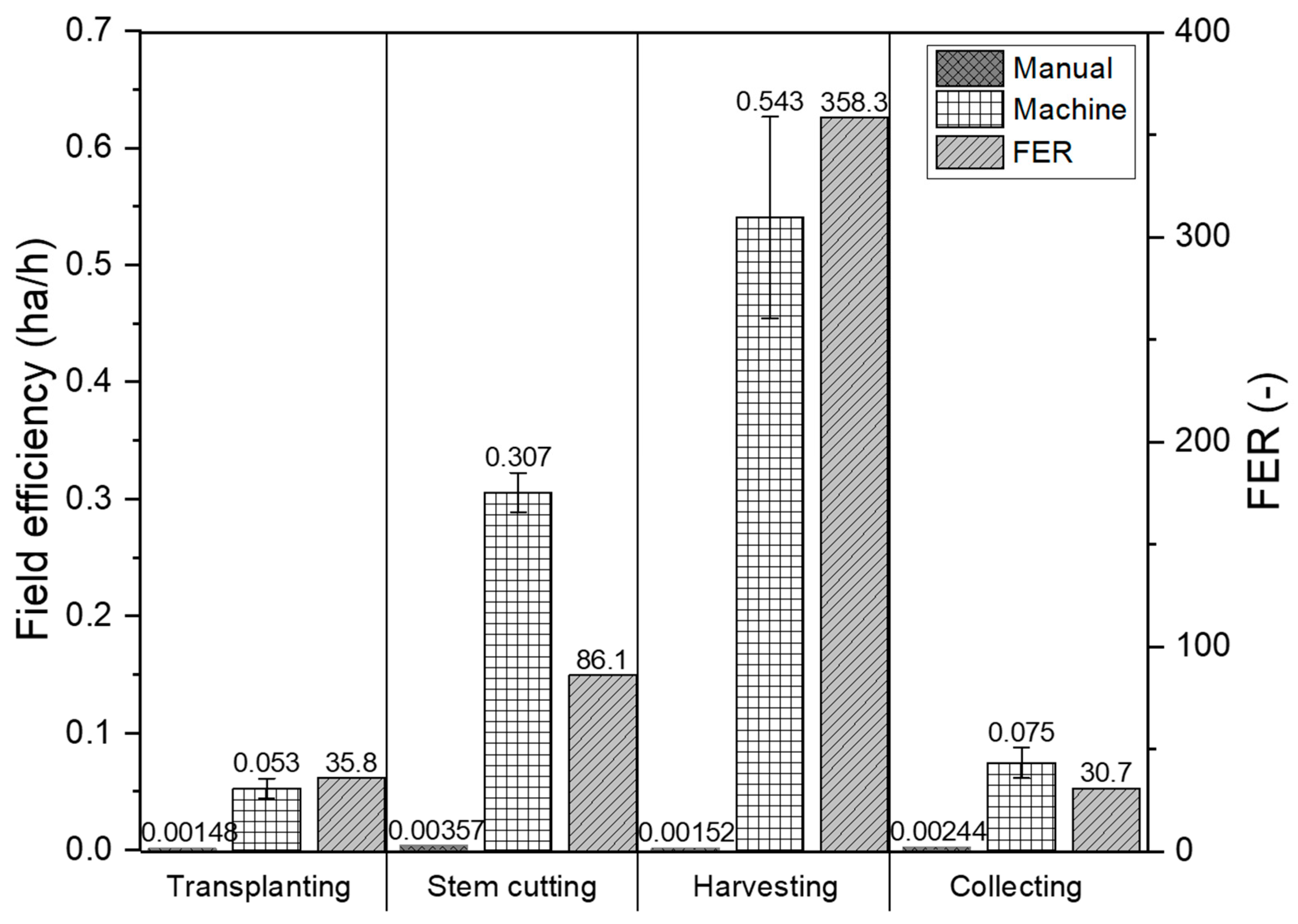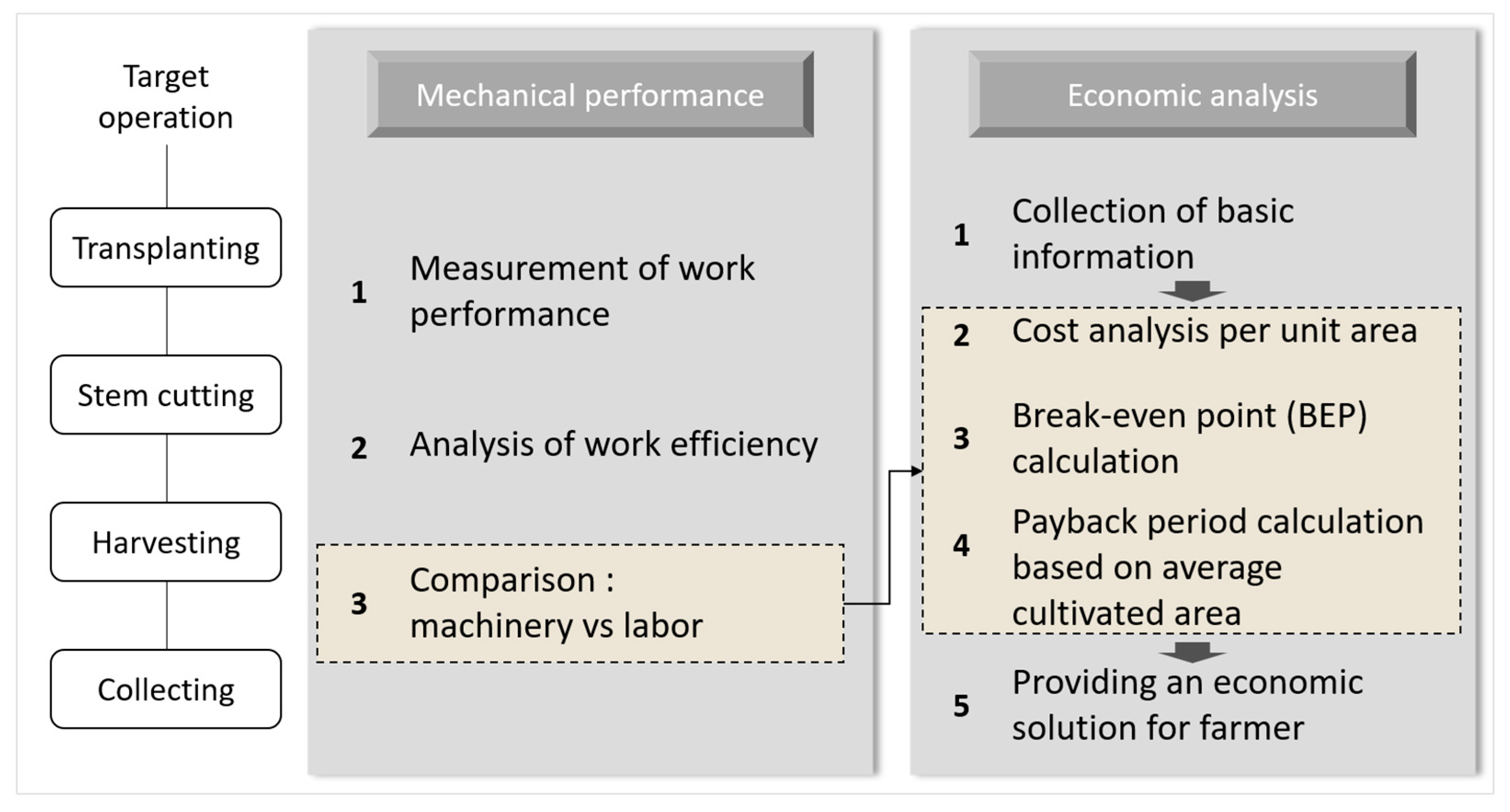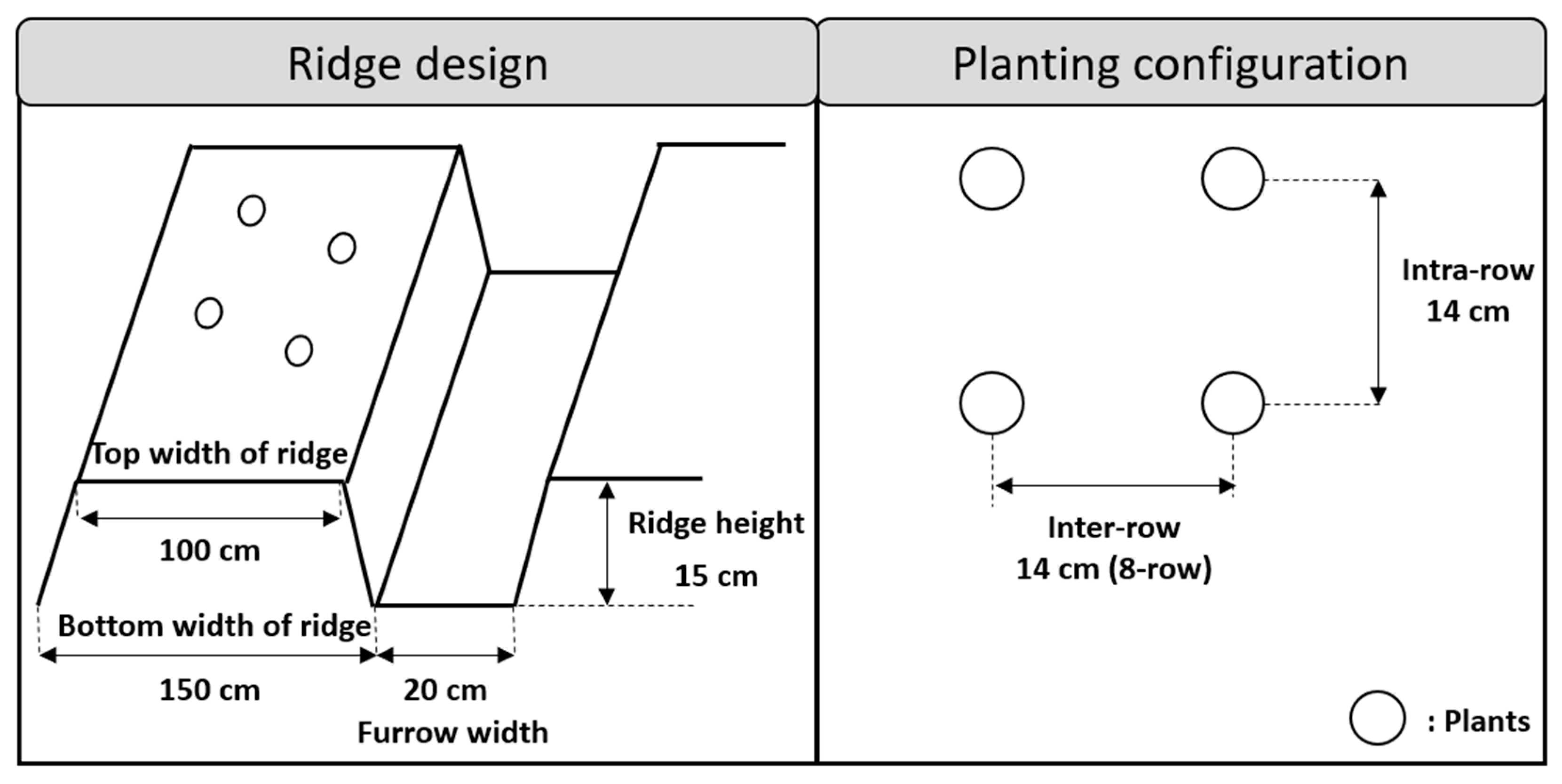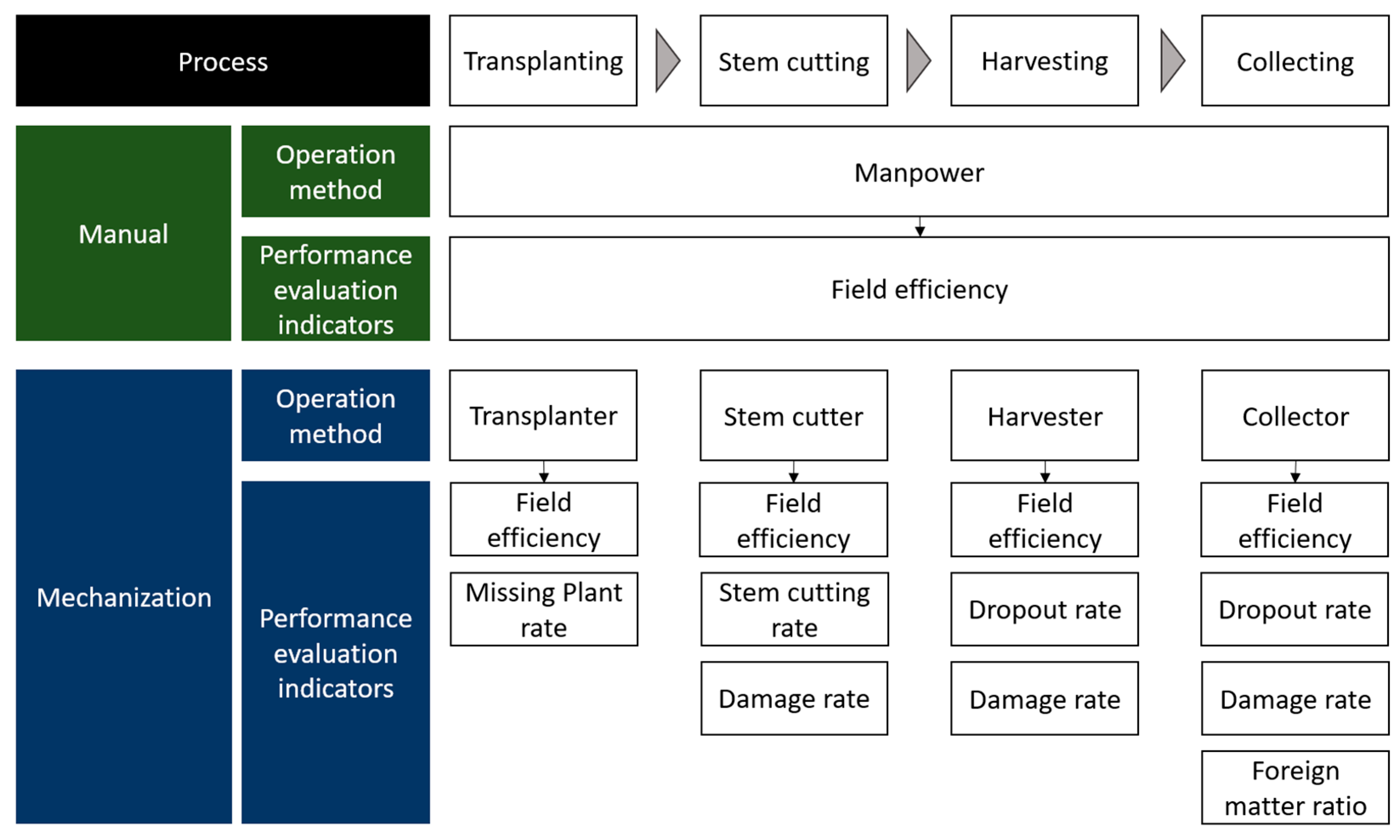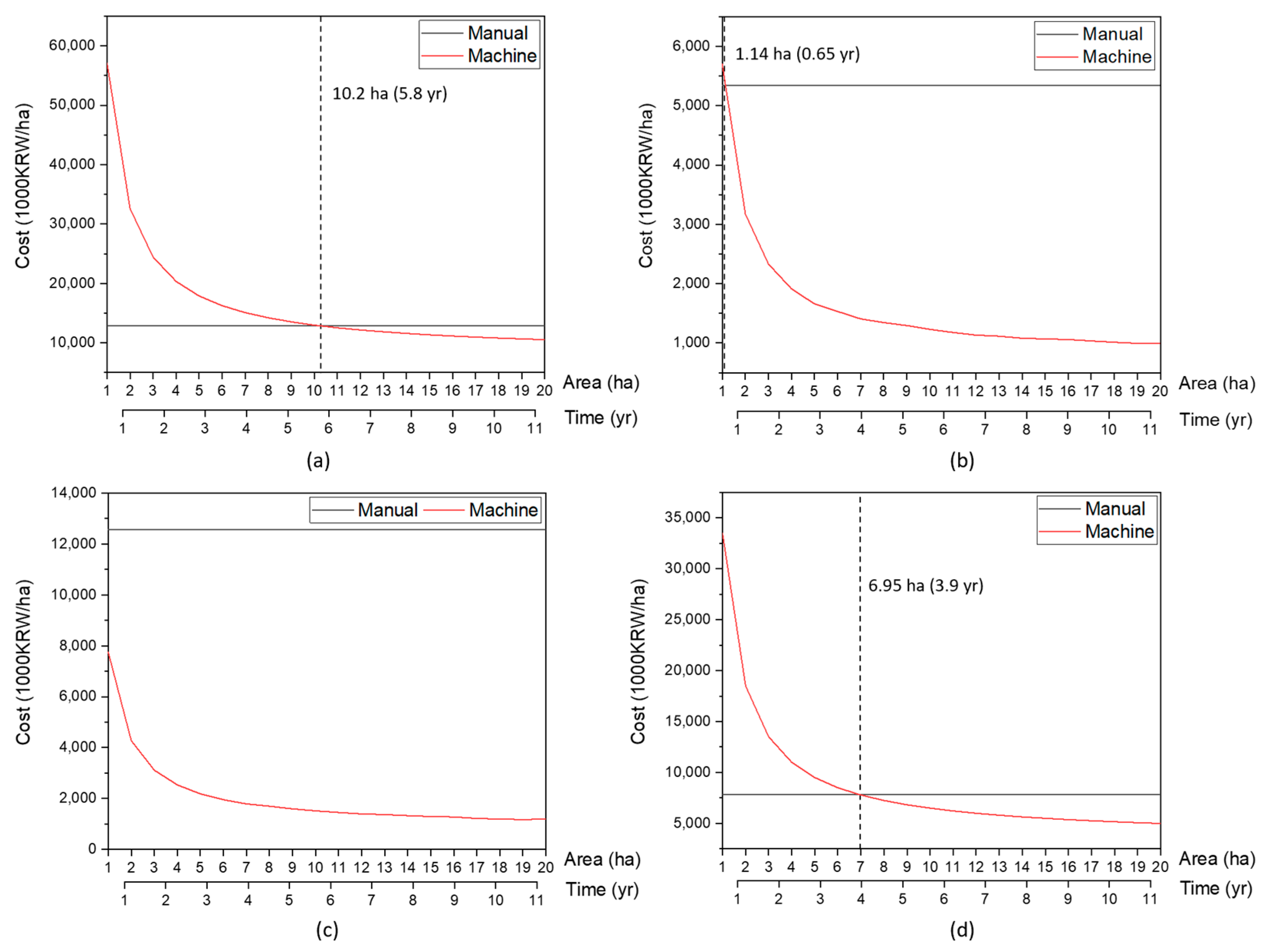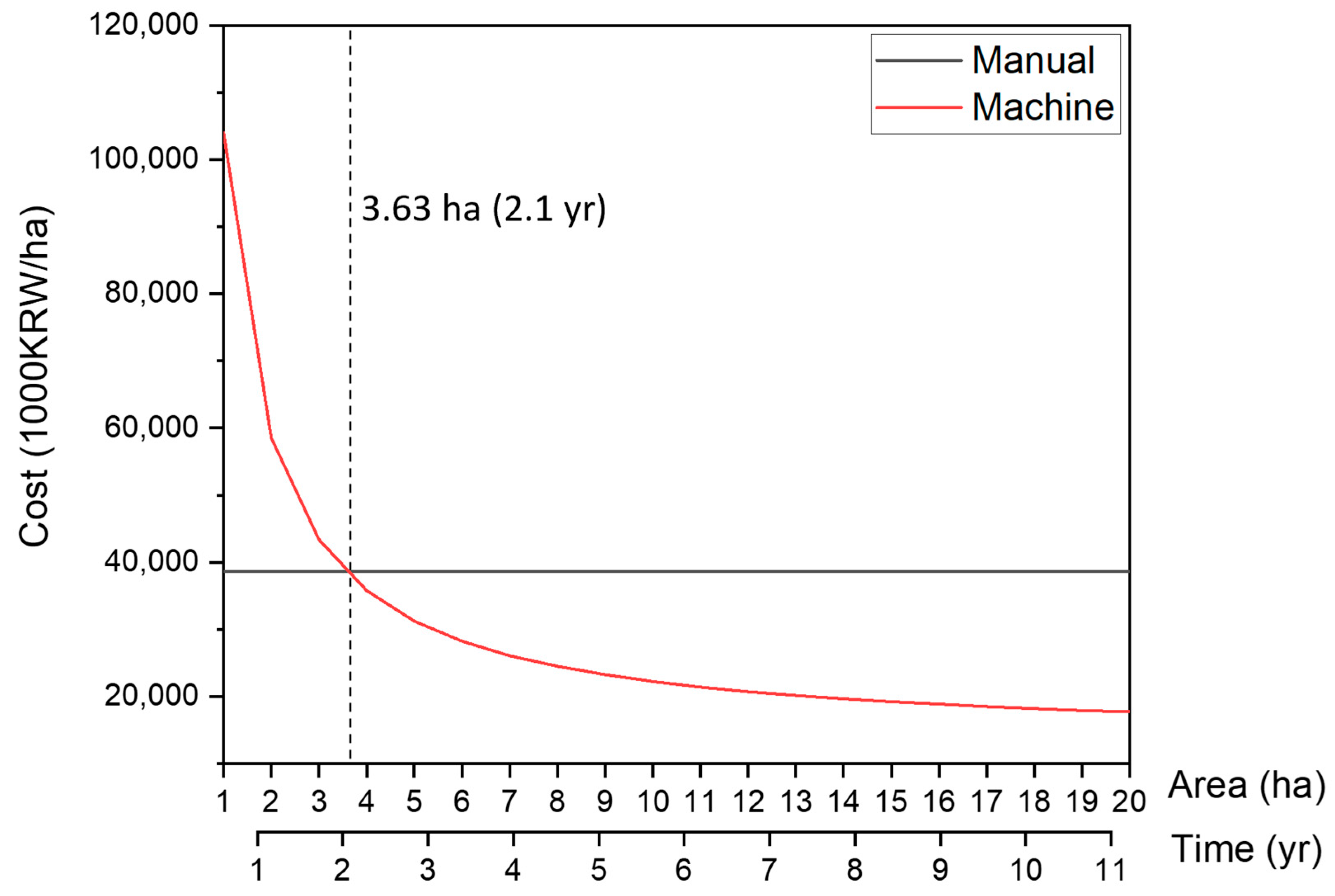1. Introduction
Korean agriculture is facing a serious crisis due to continued declines in the population of the agricultural workforce, along with the rapid aging of the rural workforce [
1]. These structural issues have led to severe labor shortages in rural areas, posing a significant threat to national food security. The population of individuals involved in agriculture was approximately 4.03 million in 2000, declining by 48.2% to about 2.089 million in 2023. During the same period, the aging index of the rural population (i.e., the number of elderly people aged 65 and over per 100 youths aged 14 and under) surged from 190.9 to 1739.5. As of 2023, farmers aged 65 and older numbered 1.099 million, accounting for 52.0% of the total agricultural population, further demonstrating the severity of aging in the agricultural sector [
2]. This shift in the labor force structure threatens the sustainability of agriculture and underscores the urgent need for mechanization and technological innovation [
3]. Mechanization in the production of key crops is expected to play a critical role in enhancing Korea’s global agricultural competitiveness and ensuring national food security.
Onions are a high-value crop and the most widely cultivated seasoning vegetable in Korea [
4]. Seasoning vegetable category crops include chili peppers, green onions, ginger, and garlic. In 2023, the total production volume of seasoning vegetables in Korea was 2.17 million tons, according to national agricultural statistics, with onion production at 1.17 million tons (54%), significantly exceeding those of chili pepper (21%), garlic (15%), green onion (9%), and ginger (1%) [
5]. Despite its high cultivation share, the rate of mechanization in onion farming remains at 70.6%, which is lower than the average for upland crops (73.7%) and substantially lower than that for paddy crops (99.8%), and mechanization rates for the labor-intensive transplanting and harvesting stages are only 24.8% and 36.2%, respectively, indicating an urgent need for mechanization in these processes [
6,
7]. However, mechanization in Korean upland crop production remains largely focused on improving the performance of individual implements, with limited integration or validation of full-process mechanization systems. To strengthen the competitiveness of Korea’s upland crop industry, it is essential to analyze the performance of existing agricultural machinery and establish a systematic mechanization strategy.
Although several machines applicable to onion farming have been developed, such as seeders, transplanters, harvesters, and collectors, most previous studies have focused on the design and operational performance of individual machines. Additionally, performance evaluations have typically been conducted in isolation, targeting only a specific stage of the cultivation process. For example, Hong et al. [
8] analyzed the cutting efficiency of a tractor-mounted onion stem cutter under varying engine speeds, while Do et al. [
9] examined the power requirements of a self-propelled garlic collector at different travel speeds. Kumawat and Raheman [
10] evaluated the performance of a hand tractor-powered onion digger-cum-conveyor by analyzing draft force requirements at varying rake angles and digging depths. Choi et al. [
11] developed a gathering-type garlic harvester and evaluated its performance based on damage, harvest, and loss rates. Similarly, Lee et al. [
12] assessed onion harvesting operations, limited to stem cutting, harvesting, and collecting operations, using indicators such as the stem-cutting, damage, and loss rates and harvesting efficiency.
While a few studies have incorporated economic evaluations, they have also typically focused on individual machines rather than the entire cultivation process. For instance, Kim et al. [
13] evaluated a self-propelled potato harvester using indicators like field capacity, damage rate, loss rate, and foreign material content, comparing its economic feasibility with that of a conventional tractor-mounted harvester. Similarly, to evaluate its economic feasibility, Kim et al. [
14] compared the total hourly cost, field capacity, and cost per 1000 m
2 of a tractor-mounted multi-working machine with those of individual machines performing tillage, land leveling, sowing, and covering operations, and Koo and Kim [
15] analyzed the field capacity and operating cost of an integrated tractor implement for flat ridge preparation, finding that it offered higher efficiency and lower cost per unit area than using individual machines. Though valuable, such analyses remain limited in scope, addressing only a single stage of operation and lacking a holistic view that addresses real-world applicability across multiple processes.
To address these limitations, the present study adopts an integrated approach by evaluating the combined performance of mechanized transplanting and harvesting operations, addressing the major parts of the onion farming process. Furthermore, it conducts an economic analysis that simultaneously considers both operations, offering a more comprehensive and field-relevant perspective.
This study aims to quantitatively evaluate the performance of mechanized operations for traditionally labor-intensive processes in onion cultivation—transplanting, stem cutting, harvesting, and collecting—and compare them with manual operations. Specifically, actual field trials were conducted to obtain operational speed and performance indicators for each stage when using machinery, while manual operation data were compiled from prior studies. Furthermore, the economic feasibility of adopting mechanization was analyzed by calculating the minimum cultivation area required to economically justify it under different operational conditions, such as adopting mechanization for transplanting only, harvesting only, or the full cultivation process. Unlike previous studies focusing on paddy crops or individual machines for upland crops, this study is significant in that it provides the first integrated performance evaluation and economic analysis of the entire onion cultivation process. By presenting the minimum economically viable cultivation area for mechanization under different operational conditions, this study provides practical, objective decision-making criteria for farmers considering mechanization.
4. Discussion
This study evaluated the performance of mechanized operations across four major stages of onion cultivation—transplanting, stem cutting, harvesting, and collecting—comparing them to manual operations, and assessed the field applicability of mechanization using an economic analysis. The results showed that mechanized operations exhibited 35.8 to 358.3 times higher work efficiencies than manual labor across all stages. The greatest difference was observed in harvesting, where manual work involves workers bending over and pulling crops directly from the soil by hand, requiring high physical labor intensity and frequent work delays. In contrast, mechanized harvesting maintained a consistent travel speed and digging depth, enabling continuous digging and conveyance with significantly reduced operation time. When all processes are mechanized, the integration of digging, collecting, and conveyance during the harvesting stage is expected to minimize idle time between tasks, enhance overall work efficiency beyond what is enumerated in this study. However, performance evaluations revealed several quality-related issues, including missing plants during transplanting; incomplete stem cutting; crop damage during stem cutting; and crop damage, dropout, and foreign matter mixing during harvesting and collecting.
Detailed performance evaluation revealed that the missing plant rate in the transplanting stage was 14.6%, which exceeds the 4–13.7% range reported in previous studies [
24]. This elevated rate appears to result not only from mechanical factors such as soil conditions and equipment malfunctions, but also from plug-tray issues, including non-germinated seedlings. When considering only mechanically induced losses, the rate falls within the previously reported range. In the stem cutting stage, the cutting rate reached 82.0%, representing a marked improvement over the 53.1–64.1% reported in earlier work [
8]. The damage rate remained very low at 0.56%. This increase is attributed to lowering the blade height and increasing rotational speed to enhance cutting efficiency, which in turn caused excessive penetration into the onion epidermis. During the harvesting stage, the damage rate rose to 9.5%, exceeding the 5–8% observed at a forward speed of 0.5 m/s in prior research [
25]. The dropout rate was 16.0%, substantially higher than the 0.13–1.11% reported for operations at 0.16–0.3 m/s. These increases are likely due to a bottleneck effect in the digging and separation unit caused by the higher operating speed. In the collecting stage, the damage rate was 0.28%, substantially lower than the 6.7–7.8% reported for a garlic collector in previous work [
25]. The dropout rate reached 18.0%, exceeding the previously reported average of 8.5%, which is likely attributable to the collector’s narrower working width, reducing its ability to capture onions at the ridge edges. Conversely, the foreign matter ratio was just 1.0%, below the approximately 2% documented in prior studies, a performance attributable to the structural design of the chain-type conveyor system and the roughly 3 m-long conveying and discharge units that effectively removed soil clumps and plant residues during transport. The results revealed suboptimal performance in several key indicators, including the missing plant rate of the transplanter, the damage rates of the stem cutter and harvester, and the dropout rates of both the harvester and collector. Based on the issues identified in this study, future improvements in the structural design of these machines are warranted. These findings indicate that mechanized operations may lead to a deterioration in crop quality when compared to manual labor operations, suggesting that the feasibility of mechanization cannot be determined based solely on work efficiency. While improvements in work rates may potentially reduce labor costs, it is difficult to quantitatively assess income loss due to reduced crop quality. Therefore, to provide a clear basis for decision-making regarding the adoption of mechanization, it is necessary to present quantitative indicators that are immediately interpretable by farmers, such as the break-even cultivation area and payback period, through economic analyses based on work efficiency.
Our economic analysis showed that, although mechanized operations incur higher initial investment costs than manual labor due to equipment purchases, the operating cost per unit area decreases as the cultivated area increases. The stem cutter and harvester were found to be economically feasible even for small-scale farms of less than 1 ha due to their high work efficiencies and relatively low equipment costs. In contrast, the transplanter and collector had higher equipment costs and performance limitations in terms of quality and were determined to be cost-effective only when used on farms with at least 7 ha of cultivated area or after at least four years of continued use. For the full adoption of mechanization, i.e., when all four processes are mechanized, farms with a cultivated area of at least 3.63 ha were found to be suitable.
This study was designed to evaluate the field applicability of mechanized operations and to provide farmers with decision-making criteria by assessing machine performance and conducting economic analyses. Recognizing the impracticality of covering every possible scenario, we applied an idealized operational framework assuming minimal human intervention and carried out experiments in representative Korean onion-growing regions, which may limit the generalizability of our findings. In particular, with respect to machinery acquisition strategies, purchasing equipment incurs high initial costs but provides immediate and exclusive access, whereas renting involves lower upfront expenses but may lead to equipment shortages during peak seasons. Therefore, more detailed economic evaluations of these ownership strategies are warranted. In future research, field trials will be broadened to include a wider range of regions and implement configurations, and through this expansion, we will secure more extensive experimental data before applying each machine in an integrated operation that reflects a continuous workflow. Additionally, performance evaluation and economic analysis will incorporate practical operational scenarios, including various machinery ownership strategies and supplementary manual tasks such as removing foreign matter or hand-collecting dropped onions after mechanized operations. This expansion of research scope is expected to enhance the representativeness of the results and contribute to a more in-depth exploration of the applicability of mechanization in upland crop production.
5. Conclusions
This study conducted performance evaluations, including field efficiency and FER evaluation, and economic analyses for four key stages of mechanized onion cultivation: transplanting, stem cutting, harvesting, and collecting.
In the performance evaluation, the transplanter showed a missing plant rate of 14.6%, a field efficiency of 0.053 ha/h, and an FER of 35.8, indicating approximately 35.8 times higher efficiency than manual labor. The stem cutter achieved a cutting rate of 82.0%, a damage rate of 0.56%, a field efficiency of 0.307 ha/h, and an FER of 86.1. The harvester recorded a damage rate of 9.5%, a dropout rate of 16.0%, a field efficiency of 0.543 ha/h, and a FER of 358.3. The collector showed a damage rate of 0.28%, a dropout rate of 18.0%, a foreign matter ratio of 1.0%, a field efficiency of 0.075 ha/h, and a FER of 30.7. When all operations were mechanized, the overall field efficiency was 0.168 ha/h, and the average FER was 122.4, suggesting that mechanized operations were at least 35.8 to 358.3 times more efficient than manual labor, with a 122.4-fold improvement in the fully mechanized scenario.
The economic analysis indicated that the break-even cultivation area for the transplanter was 10.2 ha with a payback period of 5.8 years, while the stem cutter required 1.14 ha with a payback period of 0.65 years. For the harvester, the break-even area was calculated as 0 ha, implying immediate cost recovery within the year of adoption. The collector had a break-even area of 6.95 ha and a payback period of 3.9 years. When all four operations were mechanized, the total break-even area was estimated at 3.63 ha with a payback period of 2.1 years. These findings provide valuable decision-making criteria for farmers considering mechanization. For example, in the case of full mechanization, farms with cultivation areas smaller than the national average of 1.76 ha would require a longer operational period to achieve cost recovery, whereas farms with relatively short cultivation durations would need to secure an area larger than the break-even threshold of 3.63 ha to justify adoption.
These findings provide practical benchmarks for farmers in decision-making and offer a basis for policy support and future research. By presenting integrated performance and economic analyses, this study lays the groundwork for promoting mechanization not only in onion farming but also across a wide range of upland crops.
